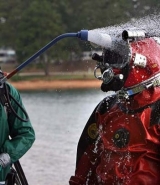
The Scuba Monkey Speaks…
How to improve your air Consumption?!
Ok. Who’s got out of the water at the end of the dive and sneakily checked how much air you had left compared to your buddy? Hands up. You bunch of liars! Everybody does it. It’s probably the one and only area of recreational diving in which everyone gets competitive.
Having more air left in your tank at the end of the dive is somehow, misguidedly, translated into bragging rights on the boat as to who’s the better diver. It doesn’t mean that at all. It just means you’ve breathed a bit more or less that your peers.
Also, ever wondered how, somehow, the dive guide or instructor you’re with comes back with more air than you? Luckily, The Scuba Monkey is here to give you some top tips for improving your air consumption.
Why do you want to improve your air consumption?
Firstly, why do you want to improve your air consumption? Aside from bragging rights back on the boat, reduced air consumption can either a) potentially extend your dive subject to no-decompression limits or, b) at the very least give you more of a safety margin to complete your dive. If you’re recreational diving in a group it’s always wise be back on the safety stop and surfacing with around 50bar/700psi. It leaves you with a margin for error and while not quite the ‘rule of thirds’ employed by Tekkie divers it does at least leave you a little buffer in case you have to deal with any problems you or your buddy may encounter on that final portion of the ascent or at the surface.
Also, if you’re diving in a group at a marine park it’s often the case that the local guide has to accompany the whole group from entering the water to being safely back on the dive deck. This means that often the guide will ask for the first person in the group who reaches 70bar/1000psi to let him/her know so they can bring the group to a safe ascent point for the safety stop on a drift dive – or a 100bar/1500psi turn point on a conventional dive. No-one wants to be that person who effectively ‘calls’ the dive. This can lead to all manner of problems for guides as people lie about their air consumption to save face, rather than admit they’ve consumed more that they might like to. This is the equivalent of saying “I’d rather die down here at 18m/60ft due to running out of air rather than admit I’ve consumed more that you…” Idiots.
What factors determine your Air consumption?
Air consumption is determined by a number of factors. Some you can actively manage and, therefore, improve. Some you’re stuck with. If you’re a big, fat guy who’s diet is 27 Big Macs a day, guess what? You’re more likely to consume more air than the petite and sweetly pretty brunette in the XS wetsuit. That’s just how it works. Step away from the burger and join a gym. You’re bigger and need more fuel to move you around – both above and below the surface.
If you’re 6ft 4in tall and built like Hulk Hogan then, of course, you’re at an immediate disadvantage with a munchkin like 5ft 1in tall Christina Aguilera. Your lungs are bigger. Get over it. But, there are a few things you can do to arrive back at the surface with a bit more gas left. Here we go:
-
Improve your fitness
Yes, I know that a worrying amount of dive guides appear to smoke, which is silly, but they usually aren’t carrying too much extra weight. If your fitness is better you’re less likely to get out of breath putting your kit on (Q: how many times have you seen a guide struggling to pop his or her fins on? A: none). You’re not going to be huffing and puffing walking to the entry point or stood on the dive deck (Q: how many times have you heard a guide complaining about the weight of the gear on their back? A: none). And, significantly, you’re not going to be huffing and puffing as you fin on the surface to join the group and get to the descent point (Q: how many times have you heard a dive guide ask for a minute to get their breath back before descending? A: none).
-
Get Equipment that fits you
If you’re wearing uncomfortable, restrictive or, alternatively, over large equipment – you’re at a disadvantage. Women always try to squeeze into equipment a size too small (I must be smaller and slimmer! I must!). Guys, on the other hand, convince themselves that they’re so ‘buff’ that they couldn’t possibly use a M or L BCD with their chest – they need an XL. Don’t be an idiot, be honest. Take advice from an experienced instructor. If you wear equipment that fits correctly you’ll be more comfortable and more streamlined in the water.
-
Wear the right equipment for the environment
If you’re about to dive at a site where there’s likely to be a proportion of the dive you have to deal with current – don’t wear your little pink full-foot fins. You may look great but you’ll be finning like hell against that current sweeping around the pinnacle at Richelieu Rock. Forget style and wear something fit for purpose. I know you don’t like wearing those chunky black Mares fins – but they’re the fins for the job. Conversely, there’s no point being kitted up like a Christmas tree with hardcore gear and enough gadgets to make James Bond jealous if you’re doing a gentle 15m drift along a reef. It’s excess baggage.
-
Don’t forget the basics
Be streamlined. Don’t forget to tuck in your gauges and octopus. This is basic stuff – PADI Open Water course Chapter 2, Question 5. And, wear a snorkel! There’s some unwritten rule that when you initially qualify it’s then time to ditch the snorkel. It’s ‘uncool’. What a load of horse manure. That snorkel will save you 20bar/300psi when you’re surface swimming to the descent point in surf and surge – as opposed to putting your regulator in. You know what’s really ‘uncool’? calling the dive 10 minutes early for you and your buddy as you’ve used that 20bar/300psi more than the rest of the group – and missing the manta ray everyone was talking about on the last part of the dive.
Also, when was the last time you did a weight check? Most divers have a habit of going in overweighted. Why carry around 2kg/4lbs you don’t need to? Equipment (and the sea) can vary so much from place to place – just because you used 8kg/16lbs in salt water with a 5mm wetsuit last summer in the Red Sea doesn’t mean you necessarily need the same this time. You might be heavier or lighter. You may be wearing a Scubapro suit instead of a Cressi. You may be in the Indian Ocean now, not the Red Sea. Don’t forget Chapter 2, Question 16 of your Open Water course.
-
Improve your skills
This is absolutely key. Your descents should be controlled. You should be releasing air in small amounts and not fighting to maintain your position in the water column. If you’re kicking like hell on your descents and ascents it’s time for a PPB course. You should be letting the equipment and the laws of physics do the work. Moving around beneath the surface should be gentle fin strokes the majority of the time – and no hands! Make sure your buoyancy and positioning is good too. If you stop finning and find you begin to drop, it’s time to go back to school. Hovering is Open Water course confined water dive 4. You really should have nailed this by now.
If you’re sinking when you stop finning it means you’re wrongly positioned, over-weighted and having to fin (and therefore use energy and air) to maintain your place in the water column. Are you paranoid about leaky masks and therefore getting anxious and breathing more? What are you doing on an Open Water dive if you’re not comfortable flooding and clearing your mask? This is something people do on a try dive! Go practice. Remember your confined water training dive no.3? you learned how to obtain neutral buoyancy by orally inflating your BCD. When did you forget that and stop using it? Use air you’re exhaling to add a little gas to your BCD instead of lazily relying on the inflate button mid-water. I do.
-
Think about your depth
Remember chapter 1 of your Open Water manual? If you go deeper you’re going to use more air. That’s just the way it is. Boyles Law: P x V = C. If you’re at 25m you’re going to use air at 3.5x the rate you do sat on the surface. So, if it’s not necessary to go deeper to see that particular wreck or piece of wildlife, don’t do it. You’ll use less air and have more time to play with before you approach your no decompression limit.
-
Relax
Professional divers don’t think about their breathing and their breathing rate. They breathe with the same intensity at 30m/100ft as they do sat on the boat having a cup of tea. No, of course you don’t want to hold your breath. But breathing shouldn’t be a conscious thing. Going for a gentle dive should be like going for a walk in the park. Breathe in slowly and deeply. Relax. Turn down the venturi on your Second Stage a fraction. And when you breathe out you shouldn’t do it consciously either – don’t ‘blow’ out – let the air trickle out just like you are right now, reading this. If it helps count to 5 in your head as you gently exhale. But don’t hold your breath or skip-breathe – that way leads to the dark side.
-
Plan your dive
Anxiety before and during the dive plays a part too. If your pulse rate goes up a notch as stress builds about the dive your breathing will often follow. Plan the dive and dive the plan. Buddy check so you know for sure where your buddy’s octopus is and how it works. Double check your air is on for peace of mind. Know how long you can safely spend at depth on that 22m dive? Find out – don’t follow the guide blindly! He’s already been diving today and may be on nitrox anyway. Know where you’re going. Wear a computer or depth gauge and watch. Be sure you’d know what route to take and what to do if it all goes pear-shaped and you find yourself separated from the group. Carry a compass and know how to use it. Carry an SMB and know how to use it. Stick with your buddy. This sounds like teaching granny to suck eggs but you’d be amazed how many people dive irresponsibly as they think “the guide will sort it out – it’s not my problem” or, alternatively, think carrying a camera makes them a solo diver.
So, there we have it. Use your head, follow some simple advice, and have more time and more fun blowing bubbles!
And you? What is your advice to consume less Air underwater?! Tell us in the comments.
The Scuba Monkey
 Destinations
Destinations








very useful tips for divers
Move slowly and deliberately. Tuck your hands so you’re not flippering around down there. Learn a good efficient kick stroke & do it with great strength, rather than flutter-kicking. Don’t move at all if you don’t have to – some (most)of my best dive moments have come when I’ve been still, and open to what’s around me.
Taking deep breath and releasing slowly reduces your heartbeat and therefore consumes less air. neutral buoyancy underwater saves you lots and lots of energy. you are able to move up or down, left or right with total ease (just a few strokes of finning). Also always stay close to cliffs,rocks when there is a current. The key word here is less energy used less air consume gives more coverage underwater. Happy diving at ease.
Fantastic, and very simple and true advices in this article.
I really agree: think and use your head before, then go diving!
Pingback: Eagle Point Beach Resort in Batangas : Underwater Cameras Bend Laws of Physics! : Discount Vouchers | Travel and Tour Batangas | Your Deal Is Here
Sure, why do not use breathing air to inflate BCD? It’a simple and efficient rule generally you can follow everywhere with no risk .
good bubbles and ….. send them into the BCD……!
Hi
Found it quite help ful still need to learn how to save air i have gone from a 10l cylinder to a 12 liter cylinder would that help too and less weights ?
Excellent tips, speaking for new divers, keen to grow in our diving skills & awareness.
Yes you quoted and referred us to the manual and qualifying dives, but the implications of these teachings, we never really understood due to limited time on the theory & short dives and I’ve only now got through your article, so thank you.
the thing with the snorkel…
it always depents on the divesites. diving in the maldives or any other place with strong currents with a snorkel is pain in the ass, especially with beginners who grab their snorkel instead of the inflator and shoot up before they notice. haveing it with you if you need to snorkel on the surface with surge and current i agree, but why do i have to wear it on my mask? there are solutions…
telling people that it is uncool to be the one who finishes the dive for a group is uncool. you need what you need, you can work on it, but sometimes it is like it is, and then please all you divers who are high in air consumption dont let anybody tell you to be blamed for a shorter dive!
my2cent
That would be my thoughts !!!